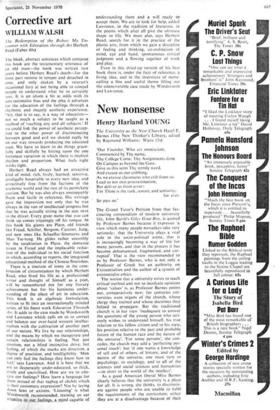Corrective art
WILLIAM WALSH
The Redemption of the Robot: My En- counter with Education through Art Herbert Read (Faber 40s) The bleak, abstract sentences which compose this book are the testamentary utterance of an old man—the book was written two years before Herbert Read's death—for the most part remote in temper and detached in tone, and only shaken by a veteran's occasional fury at not being able to compel people to understand what he so certainly sees. It is an idiom a bit at odds with its anti-rationalist bias and the plea it advances for the education of the feelings through a rhythmic and shapely aesthetic experience. `Art, that is to say, is a way of education— not so much a subject to be taught as a method of teaching any and all subjects.' If we could link the power of aesthetic percep- tion to the other power of discriminating between good and evil we should really be on our way towards producing the educated man. We have to learn to do things grace- fully and skilfully by hitting upon the one fortunate variation in which there is implicit rhythm and proportion. What feels right works right.
Herbert Read always had an attractive kind of mind, rich, lively, learned, sensitive, prodigally hospitable to every new idea, and attractively free from the factions of the academic world and the rust of its pernickety caution. But he was also always unstoppably fluent and facile in reference. His writings gave the impression not only that he was always in the van of intellectual progress but that he was actually sitting in the seat next to the driver. Every great name that you can think up comes trippingly off his tongue. In this book his giants are Plato, old friends like Freud, Schiller, Bergson. Cassirer, Jung, and new ones like Schaeffer-Simmerns and Mao Tse-tung. He glides rather smoothly by the totalitarian in Plato, the domestic tyrant in Freud and the implacable reduc- tion of the individual to his social function in which, according to reports, the integrated educational method of the Chinese flourishes.
There is a tincture of irony in the com- bination of circumstances by which Herbert Read, who lived his life as a professional v.riter and thought of himself as a poet, will be remembered not for any literary achievement but for his luminous under- standing of the place of art in education. This book is an algebraic formulation, written to fit into an internationally minded series, of his finest work Education Through Art. It adds to the case made by Wordsworth and Lawrence which calls on us to correct and balance our over-lucid western intellec- tualism with the cultivation of another part of our nature. We live by our relationships, and the means by which we inaugurate and sustain relationships is feeling. Not just emotion, not a blind instinctive drive, but feeling, of which the marks are direction, a degree of precision, and intelligibility. `Men can only feel the feelings they know how to feel,' says Lawrence. And it is here that we are so desperately under-educated, so thick, crude and uncivilised. How are we to edu- cate our feelings? How learn a language for them instead of that ragbag of cliches which is their customary expression? Not by laying down laws or axioms: 'Listening' is what Wordsworth recommended, training an ear a t teutive to_ our ,feelings, a mind capable of understanding them and a will ready to accept them. We are to look for help, added Lawrence, in the tradition of literature, in the poems which after all give the ultimate shape to life. We must also, says Herbert Read, search for it in the practice of the plastic arts, from which we gain a discipline of feeling and thinking, co-ordination of mind, eye and hand, spontaneous critical judgment and a flowing together of work and play.
Even in this dried-up version of his best book there is, under the fuzz of reference, a living idea, and in the interstices of name- calling a fine and useful theme filling out the unanswerable case made by Wordsworth and Lawrence.














































 Previous page
Previous page